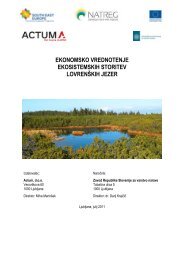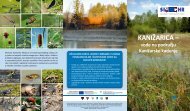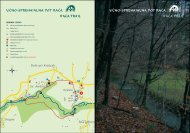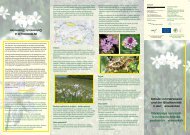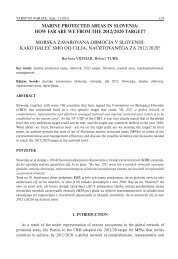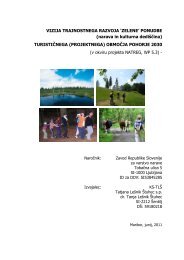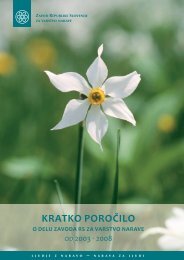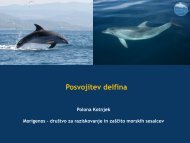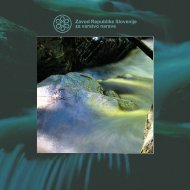Monitoring MPA visitor uses handbook
Monitoring MPA visitor uses handbook
Monitoring MPA visitor uses handbook
- No tags were found...
Create successful ePaper yourself
Turn your PDF publications into a flip-book with our unique Google optimized e-Paper software.
2.2.1 Level 1: a basic analysis to answerspecific questionsThe indicators proposed in this case can meet the requirementin a relatively short amount of time (1 to 2years) and with fairly limited means depending on thesite. These indicators are adapted to management entitiesthat wish (or are only able) to use internal skills andmeans.2.2.2 Level 2: a complete, in-depthanalysis of <strong>visitor</strong> useMore complex topics will be addressed and/or complete<strong>visitor</strong> use data must be obtained to encompass all thequantitative, qualitative, behavioural and spatio-temporalaspects. This level of analysis is more expensive andmore demanding: the required project duration is at leasttwo years and use of skilled scientific teams and specializedresearch firms is often necessary.2.2.3 Level 3: long-term monitoringThis level is appropriate for managers seeking to studytrends and variations in <strong>visitor</strong> use over time, to planfor future changes. The monitoring project demandsextensive resources and a specific organisation withinthe management entity: planning tasks and budgets,coordinating the monitoring, structuring informationin dedicated databases, etc. This kind of study alsorequires a prior overview of <strong>visitor</strong> <strong>uses</strong> obtained byimplementing the level 1 or 2 analysis. This is an essentialprerequisite to be able to test and validate the indicatorsand methods developed for long-term monitoring. Tosuccessfully complete the various steps, the managercan rely on this methodological guidance but may also,in some cases, call on specific external skills (scientists,specialized research firms, etc.).2.2.4 Level 4: need for carrying capacityevaluationThis level-4 analysis is the most complete but also themost complex to roll out. Not only does it demand extensivestudies of <strong>visitor</strong> use and long-term monitoring, italso requires multi-disciplinary studies (biology, ecology,geography, sociology, economy, etc.). Engaging reflectionon the carrying capacity largely builds on the <strong>visitor</strong>use analysis levels mentioned above. Work on carryingcapacity most often demands specific abilities providedby scientific teams and specialized research firms. Inthis respect, we should point out that extensive workhas been done in scientific spheres but that, given thegreat disparity of studies, they are not very operationalfor managers. This theme therefore remains exploratoryand applies more particularly to specific managementproblems.Determining the carrying capacity of amooring site : the example of Gocek Bay inTurkey.Turkey has 14 Special Environment Protection Areas.Fethiye-Gocek is the most suited to water-basedrecreational activities as it features many sheltered bays.There are several marinas in Gocek Bay which welcomesa significant number of boats from May to September,liable to generate major environmental disturbance. Thisfinding prompted the territory manager to wonder aboutthe Bay's carrying capacity in the face of developingwater-based activity.The studies launched on the site's carrying capacity ledthe managers to define a physical carrying capacity, anactual carrying capacity and lastly an effective carryingcapacity.The physical carrying capacity is obtained from acalculation of the possible number of boats that couldbe accommodated simultaneously based on the lengthof the wharfs and pontoons, the necessary clearancefor each boat and their frequency of rotation. The actualcarrying capacity is determined by deducting from thephysical carrying capacity areas not suited to mooring(rocks, wet areas, etc.) or requiring protection (Posidoniaoceanica beds, Cymodocea nodosa). Lastly, the effectivecarrying capacity factors in the site's managementstrategies and requirements (legislation, policies, availablestaff, budget, etc.).The results of this approach show that Gocek Bay todayhas an effective carrying capacity of 1,111 boats. Thefleet already present in the area includes 906 boats, whichtherefore greatly curbs all prospects of developing waterbasedactivities.As a result, the managers will focus in future on thedevelopment of local activities with little impact on theenvironment.Reference: Özden, G. B., 2008, A complete study on thedetermination of yacht carrying capacity in Gocek Bay(Fethiye-Göcek Special Environment Protection Area), inConference on Marine Problems and Specific Solutions,CO<strong>MPA</strong>SS 2008, Maldives, June 15-17-2008, pp. 151-159 TABLE OF CONTENTS 13 COLLECTION VISITOR USE OBSERVATION AND MONITORING IN MEDITERRANEAN MARINE PROTECTED AREAS



